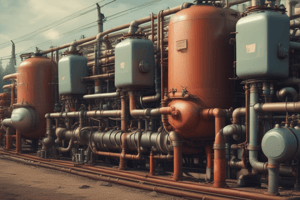Podcast
Questions and Answers
What is the primary cause of damage to converters?
What is the primary cause of damage to converters?
What is the primary component of Compressed Natural Gas (CNG)?
What is the primary component of Compressed Natural Gas (CNG)?
What component within the converter allows for expansion of the coolant if it should freeze?
What component within the converter allows for expansion of the coolant if it should freeze?
Which alternative fuel has the highest power factor?
Which alternative fuel has the highest power factor?
Signup and view all the answers
What substance is the primary component of natural gas?
What substance is the primary component of natural gas?
Signup and view all the answers
What is the typical form of Liquefied Petroleum Gas (LPG)?
What is the typical form of Liquefied Petroleum Gas (LPG)?
Signup and view all the answers
What is the approximate molecular weight of natural gas?
What is the approximate molecular weight of natural gas?
Signup and view all the answers
How is a leak detected in a natural gas system?
How is a leak detected in a natural gas system?
Signup and view all the answers
Which of the following alternative fuels is derived from corn, other grains, and agricultural waste?
Which of the following alternative fuels is derived from corn, other grains, and agricultural waste?
Signup and view all the answers
What are the two main types of fuel delivery systems used in compressed-gas engines?
What are the two main types of fuel delivery systems used in compressed-gas engines?
Signup and view all the answers
What is the typical ignition temperature range of natural gas fuels, compared to gasoline?
What is the typical ignition temperature range of natural gas fuels, compared to gasoline?
Signup and view all the answers
Which state holds about one-third of America's natural gas reserves?
Which state holds about one-third of America's natural gas reserves?
Signup and view all the answers
What must be maintained, besides temperature, for Liquefied Natural Gas (LNG) to remain in liquid form?
What must be maintained, besides temperature, for Liquefied Natural Gas (LNG) to remain in liquid form?
Signup and view all the answers
Which of these options correctly lists the octane rating in increasing order?
Which of these options correctly lists the octane rating in increasing order?
Signup and view all the answers
Which of the following is NOT specified by the National Fire Protection Association (NFPA) as a component of a CNG fuel system?
Which of the following is NOT specified by the National Fire Protection Association (NFPA) as a component of a CNG fuel system?
Signup and view all the answers
What is the main reason that using LP-Gas and CNG can increase the interval between oil changes?
What is the main reason that using LP-Gas and CNG can increase the interval between oil changes?
Signup and view all the answers
What is the primary function of solenoid valves in a bi-fuel system?
What is the primary function of solenoid valves in a bi-fuel system?
Signup and view all the answers
Where is the air-fuel mixer located in a bi-fuel engine?
Where is the air-fuel mixer located in a bi-fuel engine?
Signup and view all the answers
What is the approximate pressure range at which CNG is stored in cylinders?
What is the approximate pressure range at which CNG is stored in cylinders?
Signup and view all the answers
What is the main role of the engine control unit (ECU)?
What is the main role of the engine control unit (ECU)?
Signup and view all the answers
Which material is NOT mentioned as a possible component of CNG storage cylinders?
Which material is NOT mentioned as a possible component of CNG storage cylinders?
Signup and view all the answers
Which of the following is NOT a subsystem of the ECU?
Which of the following is NOT a subsystem of the ECU?
Signup and view all the answers
What is the maximum percentage an LPG fuel tank should be filled to?
What is the maximum percentage an LPG fuel tank should be filled to?
Signup and view all the answers
What should always be used when filling a fuel tank?
What should always be used when filling a fuel tank?
Signup and view all the answers
What type of sensors are used to monitor temperature in a CNG engine?
What type of sensors are used to monitor temperature in a CNG engine?
Signup and view all the answers
What material are the fuel lines made of?
What material are the fuel lines made of?
Signup and view all the answers
What is the recommended action to take with fuel tank valves when storing equipment?
What is the recommended action to take with fuel tank valves when storing equipment?
Signup and view all the answers
What is the approximate pressure at which the gas enters the first stage of the fuel pressure regulator?
What is the approximate pressure at which the gas enters the first stage of the fuel pressure regulator?
Signup and view all the answers
What is a key difference between fuel delivery in gasoline and compressed gas engines?
What is a key difference between fuel delivery in gasoline and compressed gas engines?
Signup and view all the answers
What is the approximate gas pressure after the second stage of regulation for a non-fuel injected engine?
What is the approximate gas pressure after the second stage of regulation for a non-fuel injected engine?
Signup and view all the answers
Why does a compressed-gas system not require a fuel pump?
Why does a compressed-gas system not require a fuel pump?
Signup and view all the answers
Why should extra precaution be taken when filling an LPG fuel tank?
Why should extra precaution be taken when filling an LPG fuel tank?
Signup and view all the answers
What is the purpose of a fuel lockoff valve in a compressed gas system?
What is the purpose of a fuel lockoff valve in a compressed gas system?
Signup and view all the answers
What is the approximate pressure of the gas before entering a fuel metering block in a fuel injected engine?
What is the approximate pressure of the gas before entering a fuel metering block in a fuel injected engine?
Signup and view all the answers
Which of these is a potential hazard associated with LPG vapors?
Which of these is a potential hazard associated with LPG vapors?
Signup and view all the answers
What is adjusted due to the higher octane rating of CNG compared to gasoline?
What is adjusted due to the higher octane rating of CNG compared to gasoline?
Signup and view all the answers
How often should CNG storage tanks be tested for corrosion and cracks?
How often should CNG storage tanks be tested for corrosion and cracks?
Signup and view all the answers
Where should you be when filling storage tanks and equipment with CNG?
Where should you be when filling storage tanks and equipment with CNG?
Signup and view all the answers
What is the primary reason for painting fuel storage tanks?
What is the primary reason for painting fuel storage tanks?
Signup and view all the answers
What is a significant challenge when working with LPG and CNG fuel systems?
What is a significant challenge when working with LPG and CNG fuel systems?
Signup and view all the answers
What is the typical duration of objective instruction at the introductory level of basic principles and practices?
What is the typical duration of objective instruction at the introductory level of basic principles and practices?
Signup and view all the answers
Which organization oversees the certification program for technicians servicing CNG and LPG systems on light and medium-duty trucks?
Which organization oversees the certification program for technicians servicing CNG and LPG systems on light and medium-duty trucks?
Signup and view all the answers
In the context of alternative fuel vehicles, what does 'bi-fuel' refer to?
In the context of alternative fuel vehicles, what does 'bi-fuel' refer to?
Signup and view all the answers
What does a 'converter' do in a compressed gas system?
What does a 'converter' do in a compressed gas system?
Signup and view all the answers
What is the first step in the CETP dual-certification process?
What is the first step in the CETP dual-certification process?
Signup and view all the answers
Which organization has developed training materials for propane carburetion installation?
Which organization has developed training materials for propane carburetion installation?
Signup and view all the answers
In the context of a compressed-gas system, what is the primary function of a 'lock-off valve'?
In the context of a compressed-gas system, what is the primary function of a 'lock-off valve'?
Signup and view all the answers
What does 'lean-burn' refer to in the context of fuel systems?
What does 'lean-burn' refer to in the context of fuel systems?
Signup and view all the answers
Study Notes
Operation and Service of LP and Natural Gas Fuel Systems
- Natural gas and alternative fuels (like LPG and CNG) are gaining interest due to environmental and economic concerns.
- Clean-burning LP gas and natural gas engines are used in various applications, including forklifts.
- Alternative fuels are often cheaper, have higher octane ratings, and extend engine life.
- Implementation of Clean Air Act led to the elimination of leaded gasoline.
- Engines using compressed natural gas (CNG) or liquefied petroleum gas (LPG) often require modifications.
Characteristics of Selected Alternative Fuels
- Compressed Natural Gas (CNG): Primarily methane (CH4). 90% methane and 10% other gases. Source: underground reserves. Energy per gallon: 114,000 BTU. Power factor: 1.00. Form: vapor.
- 15% Ethanol (E85): Denatured alcohol and gasoline. Source: corn or other grains. Energy per gallon: 80,000 btu.
- 85% Gasoline/15% Ethanol (E85): Contains a mixture of gasoline and ethanol. Forms: liquid.
- 85% Gasoline/15% Methanol (M85): A mixture of gasoline and methanol.
- Liquefied Petroleum Gas (LPG): Propane (C3H8) and butane. Source: refining or natural gas. Energy per gallon: 84,000–91,000 BTU. Power factor: 1.38. Form: liquid.
- Fuel Components/Chemical formula: Includes CH4, C3H8 etc
- Different fuels have varying characteristics: octane ratings, energy content, etc.
Advantages of Using LP-Gas and CNG Fuels
- Spark-ignition engines can use these fuels after modifications.
- Lower fuel costs than gasoline in some regions.
- Higher octane ratings than gasoline.
- Reduced harmful exhaust gases in many cases.
- Prolong engine life; fewer carbon deposits.
- Increase the interval between oil changes.
Components of EFI Compressed Gas Fuel Systems
- EFI systems are used in applications requiring variable engine speed (trucks and tractors).
- Systems minimize fuel consumption through electronic technology.
- Bi-fuel systems use two solenoid valves to switch between gasoline and compressed gases
- Air-fuel mixer mounted between carburetor and air cleaner.
Natural Gas Fuel System Specifics
- CNG is a clean-burning, less expensive alternative fuel (primarily methane).
- CNG is a naturally occurring gas and stored in cylinders under high pressure (2000-3000PSI).
- Fuel systems involve fuel storage cylinders, pressure relief valves, and a pressure regulator.
- Precise timing adjustments are required for CNG fuel systems due to its higher octane rating.
Safety Practices for Handling and Storing LPG or CNG
- Safety procedures must be followed carefully when handling and storing LPG and CNG.
- Fuel tanks should not be filled completely; space must be left for expansion.
- Vapor can ignite and cause fire hazards, so proper ventilation is necessary.
- Only trained service technicians should service or repair CNG/LPG systems
Studying That Suits You
Use AI to generate personalized quizzes and flashcards to suit your learning preferences.
Description
This quiz covers the operation and service of LP and natural gas fuel systems, focusing on their environmental benefits and applications in various engines, including forklifts. It highlights the characteristics of alternative fuels like CNG and E85, discussing their energy content and benefits compared to traditional fuels.




